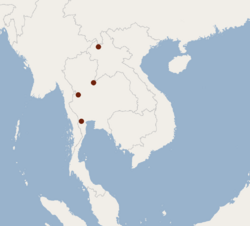Biology:Rhinolophus chutamasae
| Rhinolophus chutamasae | |
|---|---|
| Scientific classification | |
| Domain: | Eukaryota |
| Kingdom: | Animalia |
| Phylum: | Chordata |
| Class: | Mammalia |
| Order: | Chiroptera |
| Family: | Rhinolophidae |
| Subfamily: | Rhinolophinae |
| Genus: | Rhinolophus |
| Species: | R. chutamasae
|
| Binomial name | |
| Rhinolophus chutamasae Soisook & Bates, 2022
| |

| |
| Distribution of R. chutamasae | |
Rhinolophus chutamasae or the mountain horseshoe bat is a species of bat in the family Rhinolophidae. It is found from Greater Mekong in Southeast Asia.[1]
Taxonomy
Rhinolophus chutamasae was initially described with the name Rhinolophus monticolus. However, this name was judged a junior homonym of an older name, Rhinolophus monticola (Andersen, 1905), as monticola and monticolus are sufficiently similar. Rhinolophus monticola was described in 1905, and thus has priority over the species name. Therefore, a replacement name was chosen for R. monticolus: Rhinolophus chutamasae.[2][3]
Description
Small bat, with the length of the head and body between 42.3 and 48.5 mm, the length of the forearm between 41.2 and 44.1 mm, the length of the tail between 19.7 and 25.6 mm, the length of the foot between 7.4 and 8.6 mm, the length of the ears between 15.5 and 48.5 mm.
The backbone parts are dark brown, while the ventral parts are lighter. The base of the hair is complete white. The nasal leaf is brown and has a high lancet, with a blunt tip and concave margins, a relatively long connective process, pointed and projected forward, the wide saddle, with parallel edges and the square end. In some individuals the nasal leaf is coated with a layer of orange liquid with an unknown function. The lower lip has three longitudinal furrows. The tail is long and completely included in the wide uropatagium. The second lower premolar is very small and rounded.[4]
Distribution and habitat
This species is widespread in central-western and northern Thailand and northern Laos.
It lives in the mountain evergreen forests between 620 and 1.320 meters of altitude.[5]
References
- ↑ "Rhinolophus monticolus • Mountain Horseshoe Bat • Hill Forest Dweller: A New Cryptic Species of Rhinolophus in the 'pusillus group' (Chiroptera: Rhinolophidae) from Thailand and Lao PDR". Novataxa. http://novataxa.blogspot.in/2016/05/rhinolophus-monticolus.html?m=1. Retrieved 28 December 2017.
- ↑ Soisook, Pipat; Bates, Paul J. J. (2022). "Replacement name (Nomen novum) for Rhinolophus monticolus Soisook et al., 2016". Mammalia 86 (5): 539. doi:10.1515/mammalia-2022-0012.
- ↑ Template:Cite mdd
- ↑ "115 NEW SPECIES DISCOVERED IN THE GREATER MEKONG". World Wide Fund for Nature. 19 December 2017. https://www.wwf.org.uk/updates/115-new-species-discovered-greater-mekong. Retrieved 28 December 2017.
- ↑ "Crocodile lizard is one of 115 new species found in Greater Mekong". The Guardian. 19 December 2017. https://www.theguardian.com/environment/2017/dec/19/crocodile-lizard-one-115-new-species-found-greater-mekong. Retrieved 28 December 2017.
Wikidata ☰ Q24664027 entry
 |

